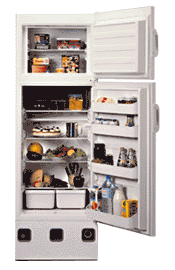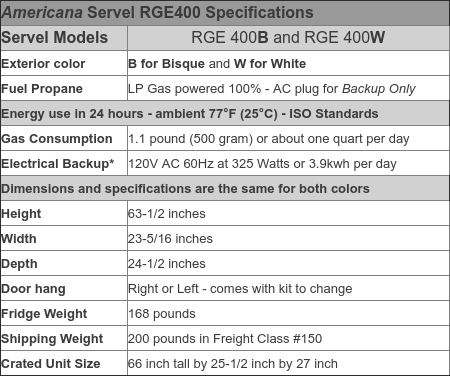Servel by Dometic RK400 kerosene powered refrigerator freezer
Servel RK400 by Dometic kerosene powered refrigerator is no longer available since they stopped exporting to their United States distributor, Dometic, back in 2018. We do not stock any parts, but replacement #23 burner assemblies are available directly from AladdinLamps.com
* 70.5" High (with feet) x 23.3" Wide x 27.2" Deep overall
* 8 cubic foot total capacity rated refrigerator and freezer
* separate freezer compartment with shelf (~1.5 cu ft)
* total shelf space of 11.5 square feet
* reversible hang refrigerator and freezer doors
* 325 watt 120 volt AC back-up power is standard
* kerosene consumption .24 gallon/24 hrs
* 6 Sturdy, rustproof wire shelves (2 in freezer)
* 4 adjustable racks in the door & 2 veggie bins
* flashlight battery powered (2 - D cell) interior light

The Servel by Dometic RK400 kerosene powered refrigerator requires no electricity to operate. Heat makes cold through the natural cooling power of evaporation and condensation. A small wick-type kerosene burner heats an ammonia mixture which is permanently sealed inside the service-free cooling coils. The thermostatically controlled flame never shuts off, providing constant cooling unlike electrical compressor refrigerators which cycle off and on. Kerosene refrigerators are exceptionally durable because the constant cycle of evaporation and condensation is performed without any moving parts, which means no mechanical wear and tear. No compressor motor also means no noise and vibration, just peace and quiet. Non-electric appliances such as a gas refrigerator are must-have items for "off-the-grid" sustainable living. When you're generating your own electricity, it's not cost effective to operate large "energy hog" conventional electric kitchen appliances. In order to keep your photovoltaic array and battery collection at a reasonable size, you'll need to buy an all-gas range, a gas hot water heater, and a non-electric refrigerator. Inverters and generators simply can't be run non-stop and expected to last for any length of time. Gas powered absorption cooling systems are extremely quiet and much more dependable than an electric refrigerator with no compressor or other moving parts to ever wear out. A tiny 'pilot light' at the kerosene burner is all that's needed to keep your food cold without electricity!
The Servel RK 400 kerosene refrigerator has all the same features and capacity as the propane gas model including back-up AC electrical power. A small heating coil does the work of the kerosene flame when you run out of fuel. Handy to be able to run on generator should you run out of kerosene or wicks. Front openings (below the door) provide ventilation, view of the fuel level pin, and allow easy adjustment of the kerosene wick. Just set the cooling level and the thermostat maintains it, in style (please note that venting is necessary with kerosene refrigerators). White (W) is the only exterior finish available in the kerosene model. The easy-to-clean white interior features adjustable, removable shelves and door bins for stocking flexibility, plus two vegetable crispers and a battery powered interior light. The large freezer compartment has a 3 position adjustable shelf. Servel made the ONLY kerosene refrigerator in the American market. We no longer have any in stock, but should you find a source, please let us know and we will share that information with others.
Kerosene powered refrigerators need their wicks adjusted weekly and their exhaust flues cleaned regularly because of soot build-up from the relatively dirty fuel. Keresene refrigerator manufacturers do not make their own wick-type burners. Aladdin® supplies all of their kerosene burners, so replacement parts are readily available. Model number is on the side of the burner or on the knob. Replacement parts are available directly from AladdinLamps.com The Servel/Dometic RK400 kerosine refrigerator uses a full brass #23 Aladdin Burner, which interchanges parts with almost all other Aladdin burners except the #32. The #23 wick burns for approximately 1,200 hours (50 days), so you need eight for a full year of 24/7 operation. We suggest also getting one spare flame spreader, 67/40 flue, and a wick raiser to make it easier when cleaning (you can simply exchange them). Always having an extra/spare burner assembly on hand would be wise in a remote location. The burner assembly and 67/40 (40mm tall) #23 burner flues are not that easy to break, but you never know. All other parts will last for many years. It is not unusual to get twenty years out of an Aladdin burner with proper care and handling.

* Electrical consumption figures are for backup power when out of gas.
Average consumption in 24 hours at 77 degree annual ambient temperature
according to ISO standards. Actual performance may naturally vary.
Servel RK400 manual plus general installation and operation tips
ALWAYS have a professional plumber install your kerosene appliance and test
ALWAYS leave the house and then call 911 if you ever smell kerosene leak
ALWAYS leave the house and then call 911 if you ever smell ammonia leak
ALWAYS monthly trim the wick and clean the burner assembly and flue above
ALWAYS shut-off the gas supply to a vacant house (turn off all gas appliances)
NEVER install a gas appliance atop carpeting or near flammable wall materials
Some items are specific to propane powered Servel RGE400, not the RK400
Always have a licensed professional plumber install your gas appliance and test for leaks. After your professionally licensed plumber has installed your gas appliance and connected the hose assembly (with dual regulator), make sure they apply a mixture of soap and water to all connections. Turn gas supply on (keep control on gas appliance turned off) and observe each connection for bubbles caused by leaks. If a connection is leaking it must be tightened until the leak stops. If a leak cannot be stopped, DO NOT USE. As with any gas appliance, professional installation is required by local building code and recommended by us since we accept absolutely no liability for any problems caused by unlicensed plumber installations. A complete installation and operation manual is included with every appliance and must be read before installing and using. We cannot be held responsible for any damage to property or to persons caused by incorrect installation or improper use of any appliance. The manufacturer reserves the right to make changes to its products when considered necessary and useful, without affecting the essential safety and operating characteristics. We are therefore not responsible for any inaccuracies due to printing, transcription, or conversational errors, whether contained in this site, any printed source, or relayed in person.
Functionally, in terms of unit operation, you can transport on the side, if you must. Always remove the glass burner flue and fuel prior to moving a kerosene powered RK400. When not possible to transport standing up, we suggest laying unit on the side opposite hinges to relieve stress on the door. Remove all interior door shelves and loose parts to avoid damage. It is especially important to allow unit to sit idle upright for at least 24, if not 48 hours before firing up after transporting on the side. Be extra careful not to damage the cooling coils on the rear of unit. If you see yellow fluid leaking that smells like ammonia, you just pierced the cooling coils - leave the house and then call 911.
Always allow a gas/kerosene refrigerator to sit idle for at least 24 hours after moving. Transporting a gas refrigerator shakes the ammonia mixture in the cooling tubes causing bubbles to appear. After moving into place, be sure to let it sit for at least a day to settle out the bubbles. Vapor lock can occur, if not allowed to settle out, causing the refrigerator to fail to reach lower temperatures. Consult the factory techs at 800-544-4881 if this happens. Typically the unit is "burped" by turning upside down for 24 hours and then right side up for another 24 hours.
A little smoke from the burner is common when first lighting gas appliances. There is always a little machining oil left on the burner parts and the flue above from the manufacturing process, so don't be surprised if it burns off with a little smoke when first lit, especially when you do not clean them first. Your installer normally wipes excess oil off burner as part of the installation process after checking burner for gas leaks (as per page 3 of installation manual), but they sometimes do not clean thoroughly. The flue above rarely has excess oil on it, but it could use a good cleaning too, if you wish to avoid a little smoke at first.
Always equip the gas supply tank (when propane) with a professionally set dual regulator at 11" water column. This is very important to ensure efficient operation as too low or too high of gas pressure can cause appliances to burn oddly. Your home's propane tank should already be equipped with a two stage (dual) regulator (as per local plumbing code). And it helps to upgrade to an adjustable regulator so pressure can be "dialed-in", especially at high altitudes. Disconnect unit from the gas supply piping system during any pressure testing.
Always level your gas/kerosene refrigerator (front to back and side to side). In the boiler of the cooling unit, ammonia vapor is distilled from ammonia-water mixture and carried to the finned condenser where it liquefies. The liquid flows to the evaporator inside the refrigerator where it creates cold by evaporating into the circulating hydrogen gas. If the evaporator is not level, the liquid may accumulate forming pockets which may impair the gas circulation or block it completely, in which case cooling will stop.
The front feet/legs are designed for leveling, not for pushing the fridge back and forth, especially when loaded. To lessen chance of damage, thread the front leveling feet all the way back up into legs/body when moving. And tilting slightly backward to relieve weight/stress on front leveling feet naturally helps, too. We highly suggest permanently installing a pair of Teflon coated "furniture sliders" under the refrigerator's front feet. These gas refrigerators are heavy for their size - moving when empty (and gas turned off) is always suggested.
ALWAYS allow at least minimum clearances (16" top, 2" sides & back). Servel and Dometic state minimum clearances of 16 inches top and 2 inch on all sides, but additional air flow is better and makes the units more efficient. The 16 inch top clearance is critical to proper operation of a kerosene burner - combustion fumes need to vent up and out unobstructed. The more ventilation around the unit the better, though, and keep the unit out of direct sunlight to reduce energy needs. Never, ever install any gas burning appliance on a carpeted floor or near flammable objects and/or walls. Ideally, the wall behind should be built of fire-proof materials and/or covered with non-flammable metal.
Never install kerosene or propane gas appliances in unventilated (air tight) structures or sleeping rooms. Gas refrigerators consume air (oxygen) when operated on gas power. When used in any inside area, provide a fresh air opening of at least 3 square inches for propane, more for kerosene (or crack a window). Please note that an exterior flue is not required by the manufacturer where there is fresh air supply, but it is always a good option, especially with the kerosene powered unit. Starting a couple of inches above the flue, run a two inch diameter galvanized vent pipe through the roof (straight up is best). If you must exit a wall, avoid 90 degree bends and try to space 45's as far apart as possible. It is recommended that a carbon monoxide detector be installed in the same room as any gas appliance.
Never install a gas/kerosene refrigerator designed for residential use in a moving vehicle. The Servel RGE400 units are not designed for mobile home, boat or recreational vehicle use. When a gas refrigerator is in motion, say in a vehicle, boat, or trailer, the continuous rolling and pitching movement will not affect the actual cooling operation of the unit, but not being level will. Safety with gas appliances is the main issue and an open flame is simply dangerous in a moving vehicle. Kerosene is particularly dangerous in a moving vehicle (or boat in motion). Once you reach a stationary point for an extended period, the gas refrigerator must be level and stable for correct operation. Operation on back-up electrical power is the only option when in motion and even then it is not assured.
Never run the electrical power and gas/kerosene power thermostats at the same time. Backup electrical power 110 volt AC operation is STANDARD equipment on the Servel gas fridge. Should you ever run out of gas, it's very handy. Just be certain to never run both heaters at the same time. Serious damage will result to the cooling unit if you do.
Never try to cool an empty gas/kerosene fridge - it confounds the thermostat. The same advice applies to electrical or gas refrigerators: refrigerating just air is relatively impossible. You should always have something in the freezer and refrigerator compartments for the thermostat to sense the temperature. If you run the unit with an empty freezer (or refrigerator compartment), the thermostat will cycle on more often, using much more fuel. Your unit will reach temperature quicker and maintain it more effectively when you load the freezer and refrigerator with frozen milk jugs full of water.
ANY gas/kerosene refrigerator's freezer compartment is not designed for quick freezing large quantities of food. It is recommended that all foods be pre-frozen before being placed into the freezer compartment. If you need to put unfrozen food into the freezer, add no more than it will freeze within 24 hours (about 2 pounds per cubic foot of freezer space adding up to 5 pounds per 4 hours until freezer is full). Keeping the refrigerator as full as possible (leave air space between packages) helps with cooling as does keeping the unit out of direct sunlight. Defrost freezer should you notice ice build-up on the cooling plates.
REPLACING an older kerosene gas refrigerator? Crating and padding is recommended immediately after removal. If you intend to use the defunct appliance for furniture, take extreme steps to protect those rear coils. Cooling liquid is nearly pure ammonia... wrapped inside what is likely a pure LEAD 'radiator' pipe. Should you puncture the cooling system, likely yellow colorant should alert you, but the odor is hard to miss. Ammonia in contact with bleach creates fumes that are "even more" toxic, so always store bleach in another room. There are a few plumbing companies that specialize in extracting 'industrial' ammonia coolant (and freon, etc), but we cannot offer personal referral. When you approach these contractors on the phone, state that you want to have them "remove ammonia cooling liquid from a refrigerant system". Best not to lead-off with 'household refrigerator'. Such firms are equipped with on-site vans for industrial locations, but you might benefit from bringing the fridge to them. Best wishes for the project.
Last updated on March 5th, 2023

